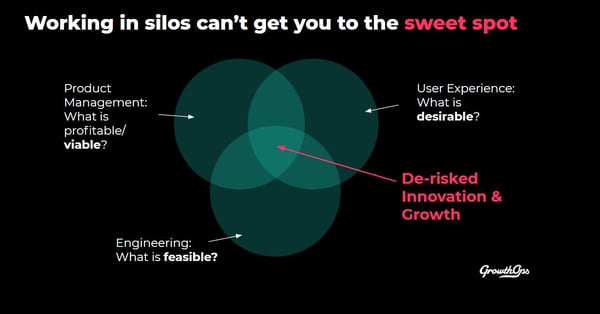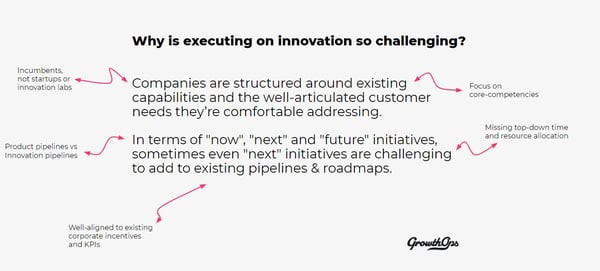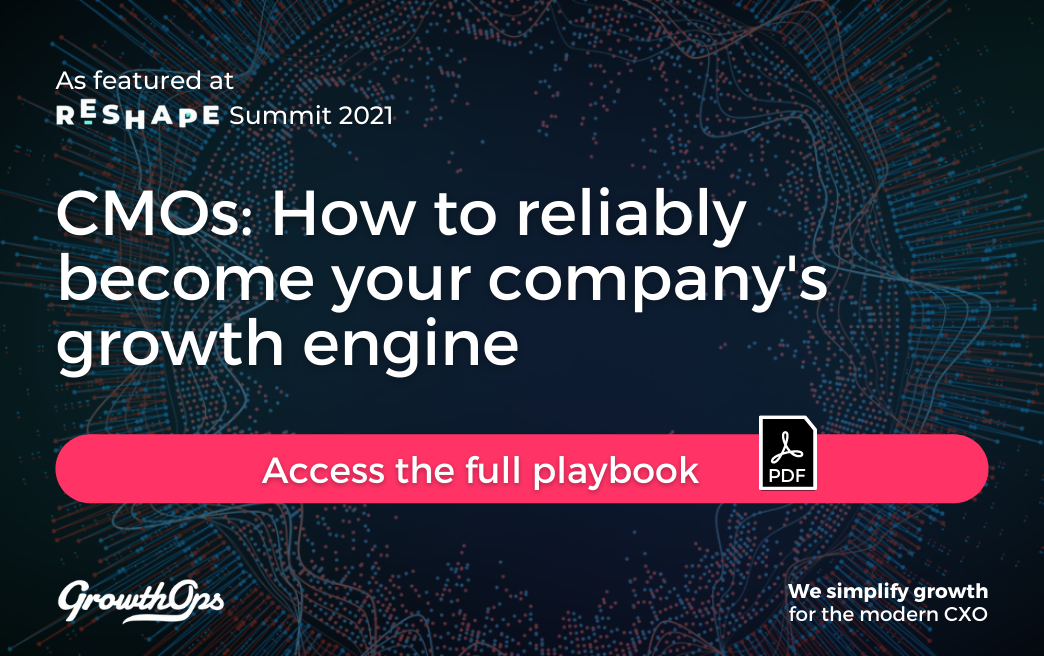NB: This article pairs with our playbook. Find the link to download it below.
TL;DR - The Summary
The role of the CMO is expanding. An effective top of funnel strategy is key for incremental growth to be possible, and the start of your go-to-market strategy.

The CMO’s access to the consumer brings customer insight that improves strategy & positioning, customer experience and even the agile evolution of product in a way that makes it more desirable to launch markets.
While the CMO does not control all the levers of growth, they still control the lever of Promotion, a key element of the top of the funnel. It’s one of the earliest touchpoints in the user journey, and is responsible for the early portrayal of value to the customer.
There is increasing organisational pressure on CMOs to become the revenue and growth engine of a company. To reliably deliver on growth, CMOs have a greater need for more data-driven decision making in the strategy development phase. A powerful source for this type of insight can come from structured, iterative experimentation as a tool that rapidly and regularly brings data to the C-suite.
With technology and advertising enabling customer access, more informed iteration pre-launch is possible. Modern techniques can collect reliable data that is more actionable. Added to greater collaboration with the Chief Product Officer, this can add more of the users voice to positively influence product benefits and priorities of feature roadmaps, and drive growth.
This is the essence of great strategy, with customer experience, positioning and product design coming together to make your business more desirable by meaningfully differentiating yourself from competitors. This approach improves the segmentation, targeting and positioning elements of your GTM strategy, where success is predicated on these elements working in synergy. That sets up your company to determine the most competitive positioning based on customer insight, and then building the product and experience to authentically deliver needs long-term, cross-functional collaboration.
“Launch faster, and also please guarantee you're driving incremental revenue.”
It’s not an easy time to be a CMO. In the midst of digital transformation, CEO’s and CFO’s are looking to Marketing as a key growth engine. In contrast with these raised expectations, the levers of growth are no longer solely under a CMOs control. Of the original Product, Promotion, Price and Placement value creation levers, only Promotion still remains solely under the control of the marketing organisation. The CMO may not always have the team, technology or authority to break down the siloes that would unlock the coordination required for the true alignment and agility that supports the delivery of growth.

To meet these new expectations around growth, the CMO needs to have the vision to coordinate more of the business and improve the shared, leading indicator metrics that are predictive of growth. It’s particularly important for the strategy and roadmaps of the CMO and the Chief Product Officer to be aligned through deep collaboration. And being customer-centric means that it’s the customer’s unmet needs that define the direction.
If prioritised customer needs can be unifying, aligned KPI’s and roadmaps would fall into place. But where does that insight come from, and who is responsible for turning it into dependable, and actionable steps to take?
It’s easier said than done. Without the right data and insight, a CMO can be challenged to get the buy-in required to provide the strategic direction needed to successfully coordinate the cross-functional teams required to deliver a winning GTM strategy and customer experience.
“This new product will sell itself.”
Launching a digital product is no assurance of monetization; it’s literally only the beginning of establishing the product-market fit before achieving a sustainable business model. The pressure is on to reap the rewards of digital transformation, wherever you are on your journey to being digital-first. The growth opportunity from launching newly developed businesses, products and features, on multiple shared and owned channels is just too great. Newly acquired innovation capabilities add to the urgency for rapid launching and consumer acquisition.
However, churn remains the enemy, and the most mature businesses understand that retention is the shared responsibility of every division that impacts the customer journey. Poor retention is an indicator that you’re not sufficiently differentiated, or dont have the right value to the customer to keep them around. Rising CACs and disappointing retention metrics are an early indicator of this in your GTM phase.
To enhance customer experience across omnichannel touchpoints, you need cross-functional team collaboration.
Without the correct emphasis on Experience, brand equity and retention are eroded (and far more rapidly in a product-led, digital-first world), leading to poor monetization, impacting key GTM metrics. Meanwhile many of the multiple touchpoints that contribute to experience move ever further from under the direct control of the CMO.
We now talk about Customer Experience the way we used to talk about Strategic Branding - an all-encompassing representation of your business in a consumer's mind, built up by their interactions across all touchpoints.
Value propositions are literally being brought to life inside the apps. Customers are exposed to ‘benefits’ for free on the way to becoming a paying customer, and thus the product experience is taking on roles previously played by marketing, sales and service.
For consistency, Marketing needs to be able to provide strategic input across the whole customer journey, from Acquisition, to Engagement and Retention.
From isolating the value proposition, to the alternatives to be pitched at dormant or bounced users, communication plays a big role in a consistent, delightful experience. CMO’s have to be responsible for maintaining this consistency, both on and off platform, and across earned, owned and paid media.
Marketing is still best placed to be the source of customer insight.
Effective segmentation and targeting is a significant part of a successful GTM strategy, and is key in the revenue growth equation. Critically, for GTM strategy, marketing’s understanding of the consumers’ job-to-be-done drives the messaging to your launch market. This messaging must carry the most effective value proposition, so that the launch can meet KPI’s.
Using experimentation to uncover the voice of the customer is possible, even pre-launch.
Customer insight is fundamental in setting strategy, priorities and roadmaps. Customer insight that is collected from observed customer behaviour is particularly predictive of unmet needs. That understanding is required to determine your differentiation and relevance, and not just from a marketing point of view, but to also improve the product roadmap.
Using the right approach to GTM strategy setting sets the CMO and CPO to better understand competitor differentiation, consumer relevance and sources of sustainable competitive advantage. A shared understanding can align both marketing strategy and product strategy so they work in synergy to achieve the company strategy. In a digital world, a key success factor is that the messaging that carries the most desirable value proposition is even woven into the onboarding experience in the product.
“Which of our various Value Propositions should lead at launch?”

Both product strategy and GTM strategy is steeped with decision anxiety around which value proposition will be the most attractive. The possibility that customers don't respond, and targets are missed, is always a looming possibility. Simon Kutcher puts the failure rate of new product launches at a demoralising 72%. In 2021, CB Insights lists the second most common reason for startup failure is “lack of market need.”
To beat those odds, it is clear that a better understanding of how relevant your product benefits are to a customers’ needs, in a competitive environment, will guide positioning during the GTM planning and the product feature roadmap.
Digital Marketing costs are rising, and efficiency is the way forward.
Compounding the issue is the inflation marketers are experiencing in the cost of customer acquisition (CACs), and the unpredictability of return on investment (ROI) with new launches. CMO’s who lead experimentation pre-launch can now be a source of dependable data. Greater clarity on ROI, and enhanced efficiency in CACs (from more effective GTM strategy) would reduce budget trade-offs at the board level.
There is a need to get the Board and the CFO on-board.
CFOs think in terms of the ROI of marketing efforts and the proforma revenue estimates. CMOs are best placed to bring the customer insight data to a strategy conversation with the CFO, and bring clarity to the board around differentiation and relevance. Even more so, budgets for structured experimentation at scale can be woven into marketing and product budgets, with the justification of more predictability for projections.
At a fraction of the overall budget, experimentation insights can significantly de-risk product innovation and GTM strategy. This quality of business impact can raise the influence of the CMO in strategy discussions. This aligns the CFO and CMO in setting the KPI’s for what is “good enough” and brings more reliability to the CMO managing the weight of the expectations of being the company’s growth engine.
Structured, hypothesis-based experimentation at scale adds efficiency to innovation
Data-driven decision-making that de-risks GTM isn't an unattainable holy grail. Structured experimentation can bring the Voice of Customer required for GTM strategy and Product Strategy direction, and even align Company Strategy to changing consumer needs. Marketing can now be the source of actionable insight that both drives feature prioritisation and makes customer acquisition more reliable.
An experimentation based approach to guiding GTM strategy can enhance your clarity around which value propositions are true sources of competitive differentiation and truly address unmet consumer needs. The right approach to experimentation can add speed, agility and dependable data to GTM strategy setting. It can improve the odds of more efficient acquisition CACs post-soft launch as well.
Over time, this level of customer insight can support the re-design of a company vision that highlights the elements of its customer-centricity. With that, the CEO and CMO tag-team can better coordinate a company strategy that is more desirable in the eyes of consumers and further drive the company towards being a top-quartile performer in their segment.
A mindset shift to being experimentation-driven brings cross-functional team alignment.
Equally valuable, an experimentation-driven approach provides the board-level justification the CMO and Chief Product Officer need to be agile. Insights that are more actionable help to drive revenue, helping to justify ROI.
This should extend into closing the loop for more iterative innovation. Marketing should be able to access product usage behaviour, key correlation data and visualise customer behaviour through the product to better target, segment and better define the value proposition to the consumer going forward.
Experimentation can drive brand equity and lower cac
With experimentation as a reliable source of actionable insight, CMO’s can align brand and customer experience to better meet the unmet needs of the consumer. A resulting stronger brand can drive pricing power and be a predictor of future cash flows. This style of customer-centric brand strategy has the opportunity to lower CAC, and thus impact profit, further enabling alignment at the C-suite.
It’s an ideal way to more reliably become your company’s growth engine.
Explore actionable steps and reduce decision anxiety to future-proof your business with customer-centric, experience-driven growth




